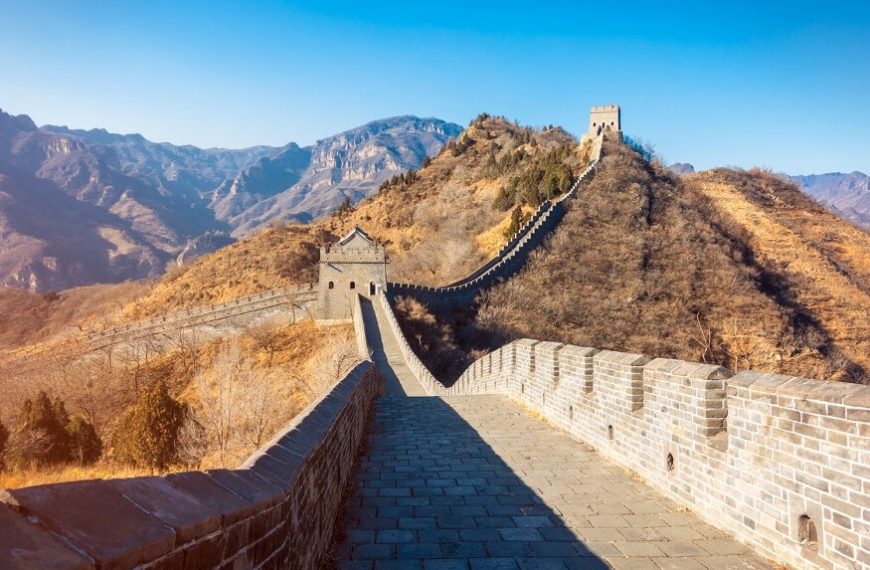The Great Wall of China is one of the world’s longest walls and the biggest ancient architecture of the century. It has fascinated people because of its structure, which extends for thousands of kilometres, and magnanimity. But how much do you think you know about this incredible wonder? We can help you satisfy your urge to know more. Here are 10 fun facts about the Great Wall of China that will entertain children and adults alike.
10 Interesting and Fun Facts About The Great Wall of China
- The Great Wall of China is Not One Single Wall
- The Great Wall of China is over 2,000 Years Old
- It Holds the Record for The Longest Wall
- The Great Wall of China is Visible from Space
- It Was Built for Protection
- Different Materials Were Used to Construct It
- It Has Been Declared A UNESCO World Heritage Site
- A Cultural Representation and Icon, Not Just a Wall
- It Was Built by Millions of People
- It’s Very Famous Among Tourists
When the words “Great Wall of China” are uttered, one might assume it is one gigantic wall. However, the Great Wall of China is comprised of a series of walls and protection forts built over time by different dynasties. Multiple dynasties of China built these walls over centuries to safeguard their empires. That’s why when you visit the Great Wall of China, you will see that some parts of the wall are partially joined to other parts, and some regions are entirely disconnected. Therefore, the Great Wall is a collection of walls, not a single structure.
The initial building of the Great Wall of China began 2,000 years ago. The earliest features were constructed in the Qin Dynasty (221 to 206 BCE) at the command of Emperor Qin Shi Huang. The construction renaissance happened in the Ming dynasty (1368 to 1644 CE). This means that parts of the wall are older than many famous historical monuments!
Stretching over 21,000 kilometres, the Great Wall of China is the longest wall in the world. If you walk the whole length of the wall, it could take you months to finish walking. Now, that’s a mandate exercise!
There’s a myth that the Great Wall of China is visible from outer space. Unlike popular belief, this is inaccurate. The wall is too narrow and blends in with its surroundings. In short, making it nearly impossible to view from space with the unaided eye.
The Great Wall of China was built to protect China from invaders. Different dynasties built walls to keep out nomadic tribes and armies from the north. The wall wasn’t just a physical barrier—it also had watchtowers, barracks, and signal towers to help soldiers communicate and defend the country.
Different materials unique to each region were used to construct the Great Wall. Some builders used tamped earth, wood, and bricks, whereas others used stone and even rice flour for mortar. Yes, you heard that right, rice flour! It certainly sounds like engineering ingenuity on steroids. That sticky rice flour helped bind the bricks together, thus strengthening the wall.
China’s Great Wall was designated a UNESCO World Heritage Site in 1987 because of its unparalleled cultural and environmental value. This designation indicates that it is a location of extraordinary universal importance. Millions of travellers from all over the world visit the wall every year to admire its breathtaking beauty and learn about its history.
Having greater significance than just a wall, the Great Wall of China stands as an icon representing Chinese culture, power, and skill. This represents a significant achievement born from tremendous effort and dedication. For children, it inspires them, demonstrating that teamwork and perseverance can conquer even the most daunting obstacles.
There is no way constructing the Great Wall was easy. It’s suggested that approximately millions of workers, ranging from soldiers and peasants to even prisoners, worked on its construction. Sadly, because of the working conditions, a significant number of workers never came back home. Nowadays, the wall serves as a reminder of their work ethic and commitment.
Out of all the landmarks worldwide, the Great Wall of China is one of the most popular. Famous portions such as Badaling and Mutianyu, which are located not far from Beijing, are famed for garnering tourists from every region of the world. If you are one of the Indian families planning to visit China, don’t forget to add the Great Wall to the list. In addition to having amazing views, it is also a wonderful place to understand history.
Conclusion -H2
We hope you liked the fun facts and trivia about the Great Wall of China. Every visitor who explores the Great Wall of China is profoundly impacted by its vastness, historical significance, and celebration of human ingenuity. Anyone interested in the past will find this majestic structure intriguing as it provides insight into the history of human civilisation.
Are your kids history buffs? Check out our blog, Inspirational Historical Figures For Children To Learn About, where we discuss some popular historical figures. Don’t forget to check out EuroKids Blogs for more insights into your little one’s development, nutrition, and learning.
For parents who wish to ignite their children’s curiosity, EuroKids is here to help. We strive to foster creativity and imagination through enjoyable learning methods. Check out our site for detailed information on our various programs and how we can assist your child in discovering the world’s beauty.
















